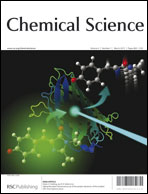Amphiphilic amino acids: a key to adsorbing proteins to nanopatterned surfaces?†
Abstract
It has been suggested that amphiphilic amino acids play an important role in the adsorption of proteins on nanostructured surfaces with an ordered, striped domain structure such as those presented by monolayer-protected metal nanoparticles (MPMNs). We have proposed and now further explore this hypothesis by studying the adsorption behaviour of proteins on MPMN surfaces by molecular dynamics (MD) simulations. Our atomistic MD simulations of lysozyme (Lyz) on nanostructured surfaces, including single component surfaces and several theoretical nanopatterns of different spacing, presented here confirm the special role of amino acids containing sidechain amines in facilitating direct protein adsorption to MPMN surfaces. While we have previously demonstrated that an amphiphilic amino acid lysine is responsible for selective adsorption behaviour of Cyt C on nanostructured surfaces, in the case of Lyz it is the amphipathic character of arginine that enables the protein to form close contacts with both polar and non-polar surface ligands simultaneously. This renders it especially important for interactions with surfaces composed of adjacent nano-scale chemical domains. Arg is also capable of forming close contacts with homogeneous hydrophobic and hydrophilic ligand surfaces. We have also found that other amphiphilic amino acids, such as tyrosine and tryptophan, interact with surfaces via water-mediated contacts. Bridging water molecules adopt orientations which differ from those of simple surface-adsorbed waters, with the specificity of their orientations facilitating the protein-surface contacts. Our findings suggest that not only nanopatterned surfaces can be designed to selectively interact with different proteins but proteins may be engineered to specifically interact with nanomaterials by targeted incorporation of synthetic amino acids which can mimic natural amphiphilic amino acids possessing multiple affinities to different chemical motifs.


 Please wait while we load your content...
Please wait while we load your content...